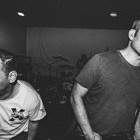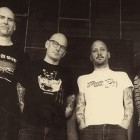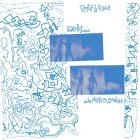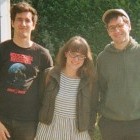
In my opinion, Terror's Lowest of the Low is the most pivotal record of the 2000s.
At a time when hardcore music had strayed from its roots, with bands becoming more preoccupied with their image and major label success, Terror took a different path with their 2002 debut EP.
The Los Angeles hardcore quintet released a raw, hard-hitting record that returned to the essence of hardcore. Combining influences from Madball, Hatebreed, and Leeway, with enough originality to stand on its own, Lowest of the Low is fast, furious, and undeniably authentic. The EP and band revitalized my love for hardcore when I needed it the most, and the influence of this record is still felt over 20 years later.
Here's the story of the making of Lowest of the Low from the people who made it.
Todd, after the release of the 2002 Terror demo, what were the first songs you remember writing for Lowest of the Low?
(Todd Jones, guitar): The demo had "Life and Death," "Better Off Without You," "Nothing to Me," and "What Have We Done." The following 2 songs we wrote were "Don't Need Your Help" and "Push It Away" which were released as a 1-sided 2 song 7" by Takeover Records.
Following those 2 songs, we put together "Better Off Without You," "Keep Your Distance," and then the title track.
From your perspective, Nick, what can you tell us a little bit about the song writing process leading up to this recording?
(Nick Jett, drums): The record was kind of a compilation of sorts. It included our demo songs, our two songs from the 7” on Takeover Records and and two new songs. We wrote the demo in late 2001 into early 2002 ("What Have We Done," "Life and Death," "Nothing to Me," "Another Face"). The 2 songs from the 7” were written shortly after, before our first show in April of 2002 ("Push It Away," "I Don’t Need Your Help").
"Better Off Without You," "Keep Your Distance," and "Lowest of the Low" were written sometime between, before we entered the studio in 2003.
All of these songs were written jamming in my parents garage in Granada Hills. Todd, Scott, and I would jam and work everything out together and then we would record demos off everything on my 16 track Fostex tape machine.

Writing a record is hard…Was there a certain direction you were trying to achieve with these 9 songs.
(Todd Jones, guitar): Terror started during a transitional time in hardcore culture where hardcore people were changing and moving away from hardcore. We didn't identify with that at all and we wanted to double down on hardcore and really show hardcore culture and identity to people.
We wanted to connect with people who felt the same way we did and liked the same things we liked. I remember being really influenced by the Revelation Records back catalog, NYHC, Cleveland hardcore, and modern/current bands at the time such as Striking Distance, Death Threat, and No Warning.
(Scott Vogel, vocals): Todd was a machine. Nick and Todd had a rhythm that was in perfect stride. All i had to do was focus on writing lyrics and making sure all the live shows went off. I don’t think i ever rejected a song or even had to ask for changes. I think those two made the songs… I wrote to them and at this time all things fell into place smoothly.
Terror hit the ground running and had momentum right out the gate. I am sure many other labels were interested in signing them. In your opinion, what do you think ultimately led to Terror signing with Bridge Nine to release what would become Lowest of the Low?
(Chris Wrenn, Bridge Nine Records): Bridge Nine had an equal amount of momentum by the summer of 2002. When I first started talking with Terror, I had released records with many of the best hardcore bands out at the time: American Nightmare, Death Threat, Champion, No Warning, The Hope Conspiracy, every band at was getting a lot of attention.
I’d already worked with Todd Jones on Carry On’s A Life Less Plagued LP, which was a perfect album, it just didn’t get the touring support it deserved. So I was friends with Todd and Nick and that helped. I didn’t know Scott well, but he’d been listening to a mixtape non-stop that his friend Larry Envy had given him with No Warning’s self-titled EP on one side, and the Carry On album on the other.
Scott was stoked on B9 because of that. I’m sure they could have signed to anybody, but it was really just between Bridge Nine and Dave Mandel’s Indecision Records. We went back and forth a bit, and they signed with me because I offered to buy them their first tour van. Which, I might add, was paid for entirely from the sale of Yankees Suck bumper stickers that had been sold outside of Fenway Park in Boston earlier that Summer.

A lot of legendary records came out of Mars Recording Compund. Who’s idea was it to record Lowest of the Low with Bill Korecky in Ohio?
(Nick Jett, drums): I can’t remember whose idea it was. Probably Scott or Todd but all of were huge fans of the Clevo sound and it was a really cool idea.
What were the logistics of this recording? Were you on tour at the time? Were there time constraints?
(Todd Jones, guitar): Prior to entering Mars to record Lowest of the Low, Terror had played 3 Canadian shows with A Death For Every Sin. I believe we played London, Montreal, and one other city I can't recall. During load out, we forgot Nick's kick pedal and it was left at the London, Ontario venue.
During the recording I recall us going to Guitar Center and getting a kick pedal to record with and then returning the kick pedal back to Guitar Center so we didn't have to pay for it.
(Nick Jett, drums): We flew out and did shows with The Promise and Death For Every Sin. I can’t remember if the shows were booked first and the studio dates were arranged around them or the other way around, but after the shows we ended up in Ohio to record.
I had somehow flown out with my entire drumset so I had all of my own stuff in the studio but I accidentally left my brand new double kick pedal in Hamilton, Ontario at the final show. Somehow, we arranged to get it back to us before we started recording. We had a week booked to record I believe. We finished recording in 3 days and Bill was done mixing by day 4 or 5.

How involved was Bill Korceky in the production of this record? Or was he strictly an engineer?
(Nick Jett, drums): Bill was strictly the engineer and the songs were completed worked out prior to getting to studio but Bill was very enthusiastic and helpful.
Any specific memory stand out to you from the Lowest of the Low tracking sessions?
(Todd Jones, guitar): We recorded on the outskirts of Cleveland, I believe in a city called Strongsville, and it was really rural and not much around us. We stayed in a hotel near the studio. Given our location there weren't any shenanigans as we weren't around much and also at that time, we were broke so it's not like we could spend money and get into anything wild.
We were just extremely focused on the recording and put all our efforts into that. We certainly had a good time in the studio. It wasn't stressful and everything went smoothly. Towards the end of the recording, we had some of our Cleveland area friends come and do group vocals. Frank Novinec (Confront, Ringworm, Hatebreed) and Human Furnace (Ringworm) came to the studio and Furnace did a vocal spot.
Nothing really remarkable to share but making that record was a great experience and we worked great as a unit. I'm really proud of what we accomplished and really fortunate that I had the opportunities to work together with those musicians and make the music we did and record with Bill Korecky at Mars.
(Nick Jett, drums): The first song we tracked was “Another Face,” and I destroyed the brand new snare head on the first take. We kept that take for the record, but for the rest of the songs I put my old beat up head from the shows we played back on the drum to record the rest. So, if you listen back to the record "Another Face" has a completely different snare sound.
I’m assuming you were the connection to Human Furnace, who lends his voice to the first track, "Better Off Without You." What were your initial thoughts when you heard his voice laid down to tape?
(Scott Vogel, vocals): Buffalo is only a few hours from Cleveland. I had seen Ringworm many times and got close with The Furnace. I also knew Frank from all the way back to when he was in Confront.
Of course, [Scott's previous band] Buried Alive played with Ringworm a bunch of times as well. Recording at Mars meant we needed a Clevo legend on the record. Furnace and Frank came to the studio, partied, and Furnace lent us that awesome voice. I loved it the first time I heard it I and always will.
Nick, were you already recording bands at this time? What do you remember about the studio setup and Bill’s recording process. (Nerd out with studio info if you can recall) Is there something that you took away from this session that you still use in the studio today?
(Nick Jett, drums): I had been recording bands for a few years at this time but my recording setup was pretty primitive compared to what we saw walking into Bill’s studio. I didn’t know enough about recording gear at the time so I can’t recall what equipment he had but there was a huge mixing console and a 24 track 2” reel to reel machine.
It was my first experience with a real professional recording engineer so I’m sure I soaked up a lot watching him work as I have with every engineer we’ve worked with since.

Scott, prior to Lowest of the Low It had been a few years since you last worked on a full-on record. Did you struggle writing lyrics at all for this record, or did you have some things that you felt needed to be said?
At this time, lyrics were really easy. Buried Alive had a very different vibe and feeling, so when I was writing for Terror I was looking at coming from things from like a Death Threat view, but with my own take.
Buried Alive talked about hardcore and how dark the world was/ is—Terror was doing this too, but more direct and basic maybe. Terror’s music was so energetic and intense things came to me easy to be honest.
Lowest of the Low features 9 songs in 16 Minutes and 28 seconds. In a time when bands were changing their sound, image, and song structures to appeal to the mainstream, this had to be intentional.
(Todd Jones, guitar): The running time was a result of our style. There was no intent with the length of the record.

Prior to this recording, had you heard every song with Scott’s vocals? What were your thoughts when you finally heard the finished record?
(Todd Jones, guitar): There's 9 songs on Lowest of the Low. At the time of the recording, we had heard Scott's vocals on 8 of those songs. The 9th and final song we wrote was the title track and I recall the band putting the final adjustments on that song during the recording session so Scott didn't have an opportunity to finish the lyrics or demo the song prior to recording the record.
Scott worked extremely hard and each time we made a song he would have lyrics written within 2-3 days and would be ready to perform the song. Prior to joining up with Scott for Terror, I was a fan of Buried Alive and held Scott in high regards as a singer and front person, so each time we made a new song I was really excited about hearing him do his thing because I knew it would be perfect for what we were going for when we put together the music.
After the recording, Scott, Nick, and myself got a rental car and drove into Canada to retrieve Nick's bass pedal. We listened to the final mix of Lowest of the Low at least 5 times in a row. We had a burned CD of it and as soon as it would end, it would start again and everybody seemed happy to have it play again. It felt really fresh and felt like it had a lot of replay value.

Chris, what were your initial thoughts on hearing the finished record?
(Chris Wrenn, Bridge Nine Records): Absolutely brutal. It was everything that I wanted and more.
Can you tell us a bit about the artwork for the record? Todd mentioned that the band wanted the record out as soon as possible and that they put pressure to get it done ASAP.
(Chris Wrenn, Bridge Nine Records): Yeah, it was a bit of a clusterfuck, to be honest. It was rushed, and we didn’t realize it then, but the scratchy texture used on the Lowest of the Low cover had been stolen from the cover of one of our earlier releases, American Nightmare’s The Sun Isn’t Getting Any Brighter EP:
The texture was created by Jacob Bannon (Converge, Deathwish) back in 2001. By the time it was realized, the person who did it had left town because of some other sketchy stuff. I credited Bannon on later pressings of the record.

This is the record that put Terror on the map. Looking back, is there anything you would have done differently with this recording?
(Todd Jones, guitar): We were really inspired by Cleveland bands such as Ringworm, Integrity, etc., and we wanted to have the experience of recording at Mars with Bill Korecky who had engineered records we loved that were done by those bands.
The recording still sounds great to my ears and the recording experience we had with Bill was very smooth. There's nothing I recall in the past about the recording that I would change and listening now, I don't hear anything I would change. We went into the studio very focused and very prepared and to my ears the recording reflects that.
(Scott Vogel, vocals): I wouldn’t change anything with the recording, but a the record cover could have and should have been better. I don’t know why we settled for the art, but that’s the one regret I have. I am still very happy with the music and songs, and that’s kinda awesome.
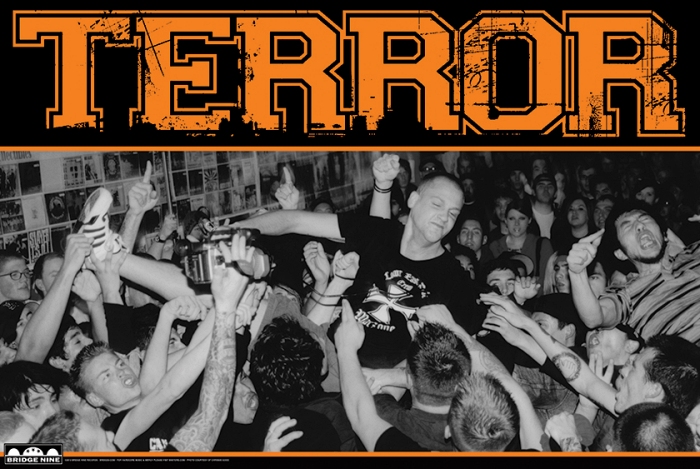
Can you talk a bit about the impact Lowest of the Low had on the trajectory of Bridge Nine?
(Chris Wrenn, Bridge Nine Records): That record was a big deal for Bridge Nine, it helped me bring the label to the next level, and all of the people it attracted stuck around and got hyped on the rest of our roster. I placed my first full-color magazine ads for Lowest of the Low, released the label’s first music video for “Push It Away” (directed by Ian McFarland / The Godfathers of Hardcore), did licensing deals with labels in Japan, Europe, and South America.
I went with Terror on their first Japanese tour in 2003. Bridge Nine had dropped a lot of cool records by that point (it was our 34th release), but Lowest of the Low drove home the point that Bridge Nine was a label that had become undeniable.

20 Years later, and Lowest of the Low is still one of the most celebrated records in Terror’s catalog. Why do you think this record connected with so many people at the time, and why do you think it still continues to resonate with newer hardcore listeners?
(Chris Wrenn, Bridge Nine Records): It still crushes and Todd Jones is one of the best riff writers in heavy music. Scott is one of the greatest frontmen, period. His enthusiasm and love for the music and subculture are undeniable. That is why people connect with it, it’s 100% authentic.
(Scott Vogel, vocals): I think the scene was really bending and gravitating to the whole metalcore Eighteen Visions/Trustkill Records world of things when the early 2000s were happening. There were for sure bands playing traditional hardcore but Terror came along when things where going off into one direction, and we somewhat smashed things crack closer to center.
We were friends and playing with all the bands totally different than us and we were happy to get in those kid’s faces and show them our version of hardcore. Also, the band and the record were so angry, in your face, and so unrelenting that it was hard to ignore.
I think there will always be a place for what’s maybe considered “Real Hardcore.“ Hopefully, it will always have a place in the scene.

***

Tagged: 2000s hardcore week, terror




